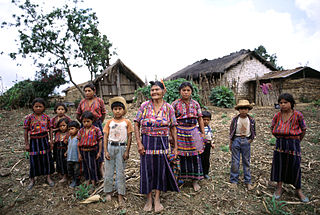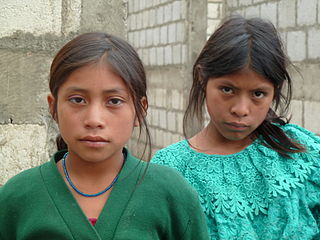
The Kaqchikel are one of the indigenous Maya peoples of the midwestern highlands in Guatemala. The name was formerly spelled in various other ways, including Cakchiquel, Cakchiquel, Kakchiquel, Caqchikel, and Cachiquel.

The Itza are a Guatemalan people of Maya affiliation. They inhabit the Petén department of Guatemala in and around the city of Flores on Lake Petén Itzá.

The Tzʼutujil are a Native American people, one of the 21 Maya ethnic groups that dwell in Guatemala. Together with the Xinca, Garífunas and the Ladinos, they make up the 24 ethnic groups in this relatively small country. Approximately 100,000 Tzʼutujil live in the area around Lake Atitlán. Their pre-Columbian capital, near Santiago Atitlán, was Chuitinamit. In pre-Columbian times, the Tzʼutujil nation was a part of the ancient Maya civilization.
The Ladino people are a mix of mestizo or hispanicized peoples in Latin America, principally in Central America. The demonym Ladino is a Spanish word that derives from Latino. Ladino is an exonym invented during the colonial era to refer to those Spanish-speakers who were not colonial elites of Peninsulares, Criollos, or indigenous peoples.

The Mam are an indigenous people in the western highlands of Guatemala and in south-western Mexico who speak the Mam language.
The Uspanteko is a Mayan language of Guatemala, closely related to Kʼicheʼ. It is spoken in the Uspantán and Playa Grande Ixcán municipios, in the Department El Quiché. It is also one of only three Mayan languages to have developed contrastive tone. It distinguishes between vowels with high tone and vowels with low tone.
The Chʼortiʼ people are one of the indigenous Maya peoples, who primarily reside in communities and towns of southeastern Guatemala, northwestern Honduras, and northern El Salvador. Their indigenous language, also known as Chʼortiʼ, is a survival of Classic Choltian, the language of the inscriptions in Copan. It is the first language of approximately 15,000 people, although the majority of present-day Chʼortiʼ speakers are bilingual in Spanish as well.
Sakapultek or Sacapulteco is a Mayan language very closely related to Kʼicheʼ (Quiché). It is spoken by approximately 15,000 people in Sacapulas, El Quiché department and in Guatemala City.
Sipakapense is a Mayan language, closely related to Kʼicheʼ spoken natively within indigenous Sipakapense communities in Western Guatemala. It is primarily based in the municipality of Sipacapa in the department of San Marcos.

The Jakaltek people are a Mayan people of Guatemala. They have lived in the foothills of the Cuchumatán Mountains in the Department of Huehuetenango in northwestern Guatemala since pre-Columbian times, centered on the town of Jacaltenango.

The Ixil are a Maya people indigenous to Guatemala. The Ixil live in three municipalities in the Cuchumatanes mountains in the northern part of the department El Quiché. These municipalities, also known as the Ixil Triangle, are Santa Maria Nebaj, San Gaspar Chajul, and San Juan Cotzal.
The Sipakapense are one of the Maya peoples in Guatemala. They speak the Mayan Sipakapense language.
The Achi are a Maya people in Guatemala. Their indigenous language is also called Achi and is closely related to K'iche'.
The Qʼanjobʼal (Kanjobal) are a Maya people in Guatemala. Their indigenous language is also called Qʼanjobʼal.
The Awakatek (Aguacateco) are a Maya people in Guatemala, primarily located in the municipality of Aguacatán (Huehuetenango). Their native Awakatek language is related to the Ixil language.
The Akatek (Akateko) are a Maya people of Guatemala. Their indigenous Akatek language belongs to the Q'anjobalan branch of Mayan languages. Most Akatek live in San Miguel Acatán and San Rafael La Independencia, in the department of Huehuetenango.
The Tektitek (Tektiteko) are a Maya people in Guatemala. Their indigenous language, which is also called Tektitek, belongs to the Mamean branch of Mayan languages. Most Tektitek live in Tectitán, in the department of Huehuetenango.
The Poqomchiʼ are a Maya people in Guatemala. Their indigenous language is also called Poqomchiʼ, and is related to the Quichean–Poqom branch. Poqomchí is spoken in Baja Verapaz (Purulhá) and in Alta Verapaz: Santa Cruz Verapaz, San Cristóbal Verapaz, Tactic, Tamahú and Tucurú. It is also spoken in Chicamán.
The Poqomam are a Maya people in Guatemala and El Salvador. Their indigenous language is also called Poqomam and is closely related to Poqomchi'. Notable Poqomam settlements are located in Chinautla, Palín (Escuintla), and in San Luis Jilotepeque (Jalapa). Before the Spanish Conquest, the Poqomam had their capital at Chinautla Viejo. The Poqomam that advanced further east, to the territories of present-day El Salvador, were largely displaced by the migration of the Pipil people in the 11th century. The few Poqomam that remained in El Salvador live near the Guatemala border, in the departments of Santa Ana and Ahuachapan.
The Uspantek are a Maya people in Guatemala, principally located in the municipality of Uspantán. The Uspantek language is closely related to K'iche'.





